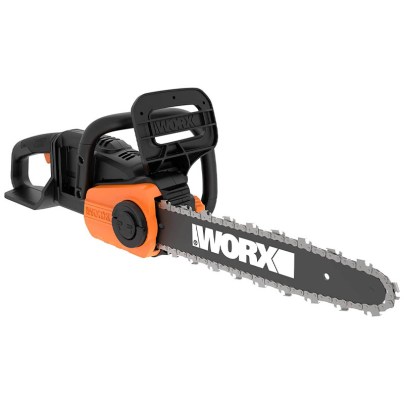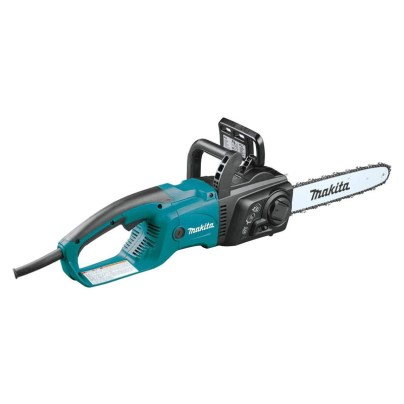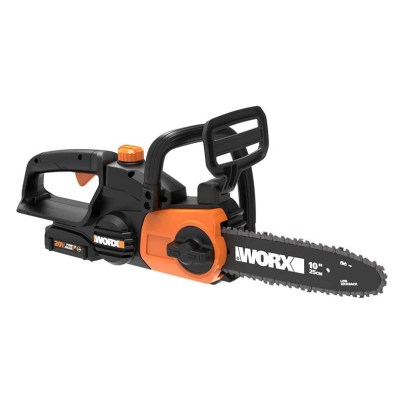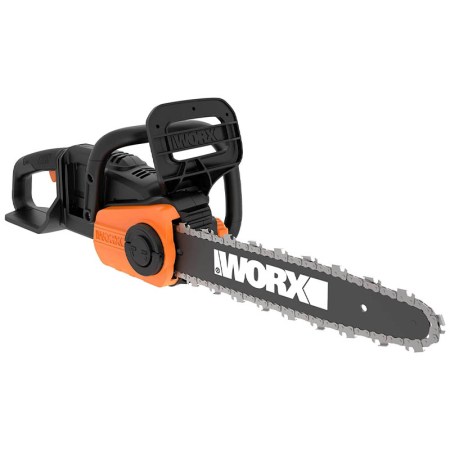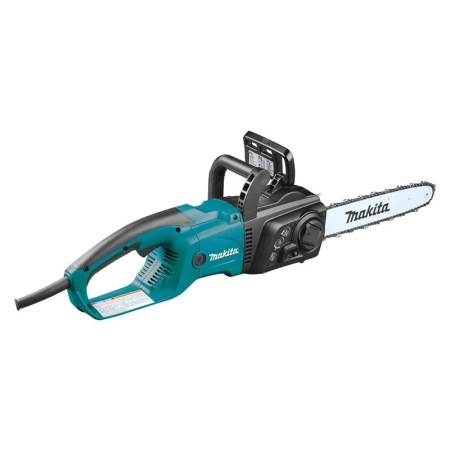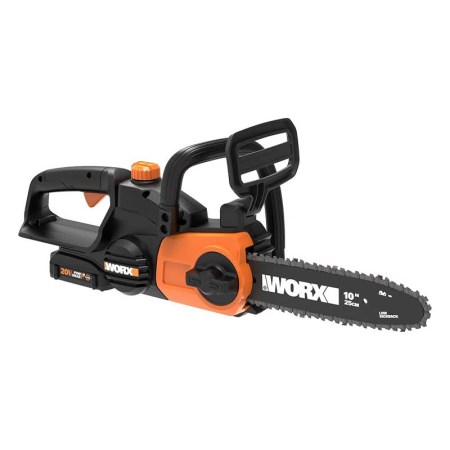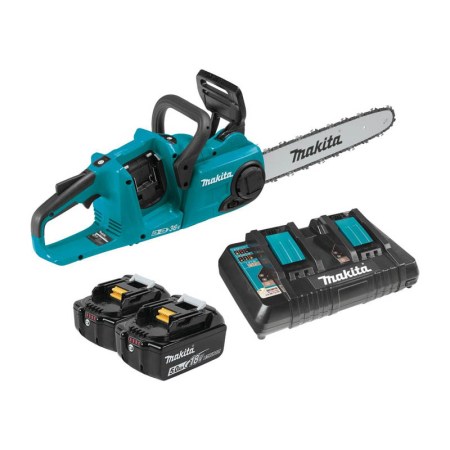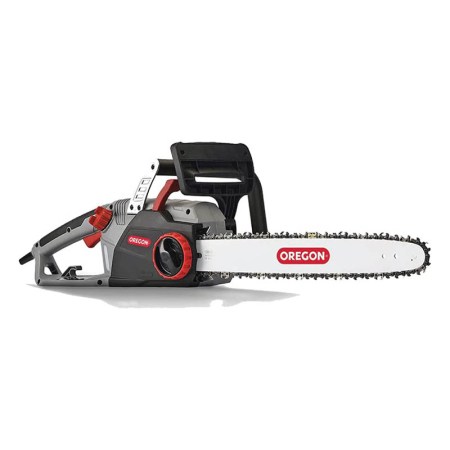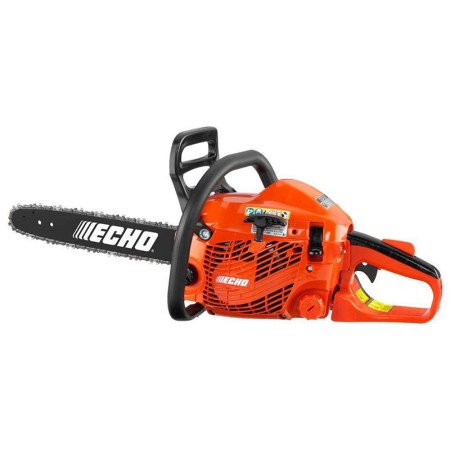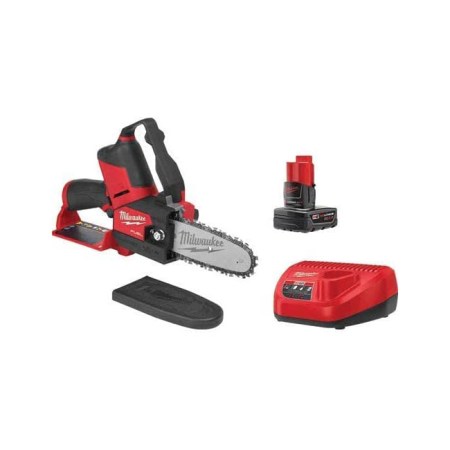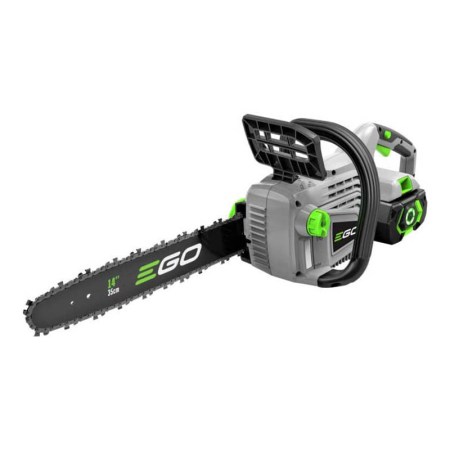We may earn revenue from the products available on this page and participate in affiliate programs. Learn More ›
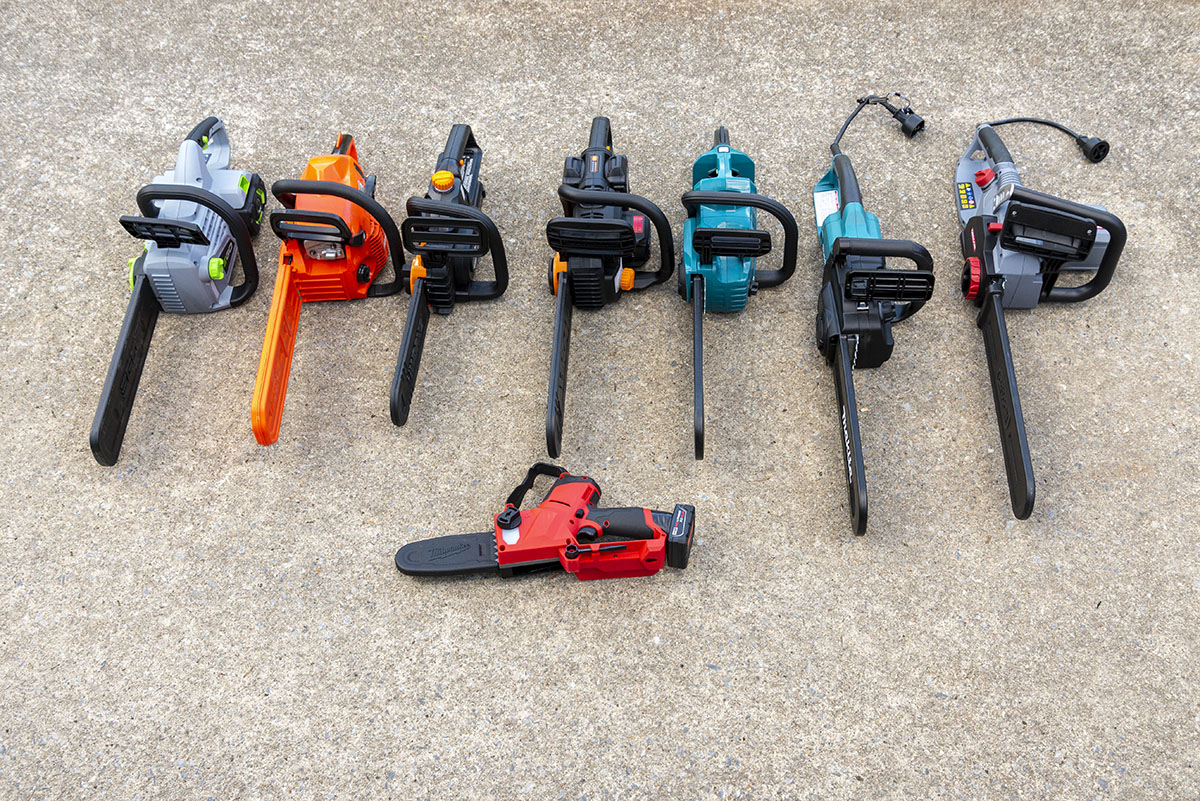
Folks with a few trees on their property may very well need a chainsaw at some point. Whether it’s because a storm knocked down some branches or a little more sunlight will benefit the garden, these woodcutting power tools can be a big help. Today’s chainsaws are available as gas- or battery-powered as well as corded models.
While a professional model isn’t usually needed for the average residence, that doesn’t mean any smaller saw will do. Ahead, we outline important features to think about when searching for a small chainsaw—criteria we used in hands-on testing for the following models. Keep reading for our detailed performance reviews to help identify the best small chainsaw for your property.
- BEST OVERALL: Worx WG384 40V Power Share 14-Inch Cordless Chainsaw
- RUNNER-UP: Makita UC3551A 14-Inch Electric Chainsaw
- BEST BANG FOR THE BUCK: Worx WG322 20V Power Share 10-Inch Cordless Chainsaw
- BEST BATTERY-POWERED: Makita XCU03PT 36V LXT Brushless 14-Inch Chainsaw
- BEST CORDED: Oregon CS1500 18-Inch Electric Chainsaw
- BEST GAS: Echo CS-310 14-Inch Gas Chainsaw
- BEST MINI: Milwaukee M12 Fuel Hatchet 6-Inch Pruning Chainsaw
- ALSO CONSIDER: Ego Power+ CS1401 14-inch Chainsaw
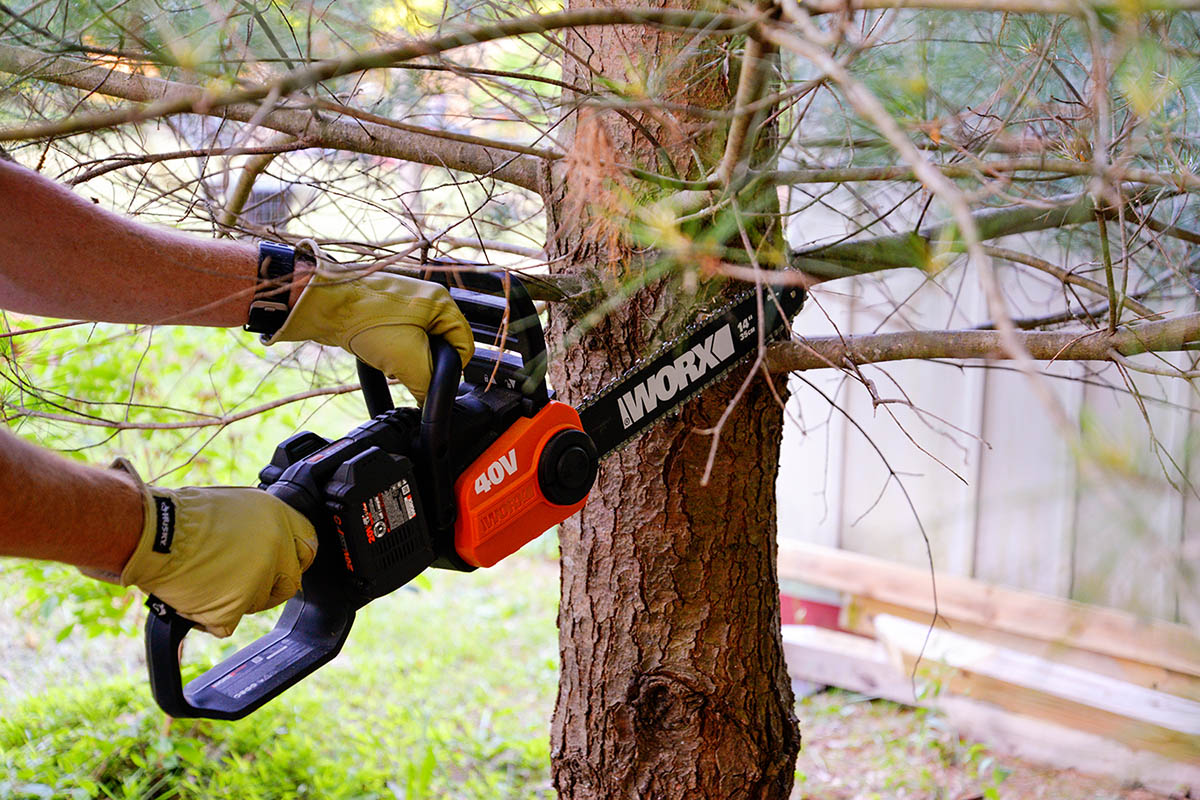
Before You Buy the Best Small Chainsaw
Whether a small chainsaw will work for a yard depends on its intended use and the property’s size. If the goal is to cut lots of firewood, then a larger, more powerful chainsaw may be better suited for the job. If it’s a large yard with mature trees, a windfall might be challenging to cut with a chainsaw bar smaller than 20 inches.
However, if the yard is relatively modest and the plan is essential maintenance, then a small chainsaw should suffice. It will be able to cut fallen branches easily and clear stubborn bushes without an issue.
The best small chainsaws are lighter than larger models, and they can be a bit less intimidating to users. They’re easy to handle, won’t tire the sawyer as quickly, and they’re usually the least expensive within a brand’s lineup. But it’s important to remember that even a small chainsaw can cause serious injury quickly, so personal protective equipment (PPE) and safe behavior are essential during use.
Types of Small Chainsaws
Before deciding on a small chainsaw, it’s important to know the differences between a few standard styles, including gas-powered, battery-powered, and corded models. Each has benefits and drawbacks, but many of the best small chainsaws usually fall within these three categories.
Gas-Powered
Typically loud and sometimes smoky, gas-powered chainsaws are serious machines capable of ripping through wood without an issue—if they’re correctly maintained. A gas chainsaw requires far more upkeep than an electric model. Users must maintain a clean air filter, use the proper mix of gasoline and oil, and replace the spark plugs regularly. These models also have carburetors, so they require adjustments to fuel and air mixtures, which can make a gas chainsaw finicky. However, if the property is on the larger side or the plan is to use a chainsaw often, then a small gas model may be the best choice.
Battery-Powered
Battery-powered chainsaws offer quite a bit of flexibility. They’re low maintenance, like a typical electric chainsaw, but they provide the portability of a gas chainsaw. Today’s options are pretty powerful yet less noisy than a comparable gas-powered model. Battery-powered saws are best suited for DIYers without sizable properties who’ll only use the tool occasionally. Minimal maintenance and portability make them among the best small chainsaws for these scenarios.
The downside is that batteries tend to be pricey, so keeping a few on hand can cost as much as the saw itself. However, many of the top manufacturers will make a battery-powered chainsaw that works with the same batteries as its power tools.
Corded Electric
Corded electric chainsaws have been around for a long time, and there are many great options on the market. They have very few maintenance needs other than a quick cleaning and maintaining the bar-lube levels. Many corded electric saws rival the power offered by gas models.
While they can handle most of the same jobs as a gas-powered saw, a corded electric chainsaw is limited to the reach of its cord, so it’s usually best suited for small yards that don’t require frequent chainsaw use. For larger areas, use an extension cord.
What to Consider When Choosing the Best Small Chainsaw
Below are some critical factors and features to keep in mind when shopping for the best small chainsaw.
Kickback
Kickback is a potentially dangerous hazard of chainsaw use. It can occur when the top half of the saw bar’s tip makes contact with a solid piece of wood. If the sawyer doesn’t have experience or isn’t expecting it, the saw bar can kick back toward the operator, causing a serious injury.
Plunge cutting the bar’s nose into a log is a technique used by skilled, experienced woodcutters. For safety, folks who don’t have years of chainsaw experience should leave the guard on the end of the bar. It’s also helpful to run low-kickback chains on a saw, which cut slower but are much safer. It’s also important to always cut with two hands on a saw at all times.
Motor/Engine Size
The size of a chainsaw’s motor (electrical models) or engine (gas-powered saws) has a lot to do with its intended capabilities. Size may also determine if it can be upgraded to a longer bar or if it is heavy duty.
For most small, gas-powered chainsaws, engine sizes range between 30 and 40 cubic centimeters (cc), which is an acceptable size engine for anything from a 10-inch or 12-inch bar up to 16 inches. An 18-inch bar is a possibility, but that’s as large as it gets with a saw in this range. Matching these bars to this engine size will provide plenty of power and torque without getting in over your head on a large tree.
For electric saws, consider amperages (amp). An electric motor’s amp rating describes how much power it can handle before internals may start to break down. Saws with a 14-amp rating are more than suitable for average residential uses.
Bar Length
The length of a chainsaw’s bar determines the type of work it’s best suited for, but short length does not typically indicate ease of use. Longer bars (24 inches and beyond) may look intimidating, but they’re actually relatively easy to control. Top-handle saws with short bars (usually 10 inches) may seem more approachable, but they can be more unpredictable and dangerous for a new sawyer. Indeed, these short-bar models are ideal for tree-climbing arborists.
A 14-inch to 18-inch-long bar saw is an excellent meet-in-the-middle size that can handle most DIY-type jobs. They can fell small trees, buck large branches, and cut firewood without much issue. These bars also are easy to find if they need to be replaced.
There also are mini chainsaws with bars just a few inches long, but they’re best for pruning duty. These blades are even smaller than the ones found on a typical pole saw.
Weight
Depending on the sawyer’s physical strength, weight can be the most critical consideration of all. If someone is unable to handle a saw safely because it’s too heavy, the fuel source or bar length simply won’t matter.
Corded electric saws and battery-powered saws are often lighter than gas options. They don’t require a full tank of fuel mix and their motors are smaller, so they aren’t as heavy and can be easier to use in a variety of scenarios.
Keep in mind, though, that it’s possible for a saw to be too light. A top-handle saw with a lot of power, a short bar, and a light motor can act unpredictably if it experiences some kickback. The added inertia of a heavier motor will help minimize the effects of kickback.
Noise Pollution
To maintain a pleasant relationship with neighbors, the less noisy the chainsaw, the better. Gas-powered saws can be deafening—100 decibels is not unheard of (no pun intended). Even some electric- and battery-powered options may be fairly loud. The whine of the electric motor and the noise the chain makes as it rips through wood combine to create some chatter. So woodcutting is best left to late mornings and afternoons, when fewer people may be sleeping.
Certainly the sawyer should wear hearing protection. There are plenty of muff-style protectors at home improvement stores to help preserve one’s hearing during a long day of a chainsaw use.
Safety Features
Chainsaws can be dangerous; there is no denying that. Fortunately, many modern models have additional safety features that help keep sawyers safe. Most importantly is an inertia chain brake. These clutch-style brakes sense the rapid change in inertia caused by kickback and lock the chain to stop it from running. If there is kickback, the brake will engage and help keep the user safe. Low-kickback chains are also now installed on most small chainsaws to minimize the effects of kickback.
Bucking spikes, located on the saw housing at the interior base of the bar, are ridges, spikes, or grippers that can improve the sawyer’s leverage when cutting through logs. Steel or metal bucking spikes easily bite into the log and become a stable pivot point. Some saws use plastic ridges or nothing at all in this position, which puts more strenuous work on the saw operator.
Even with these safety measures in place, proper protective gear must be worn. This includes chainsaw chaps, sturdy boots, eye and ear protection, and properly fitting work gloves.
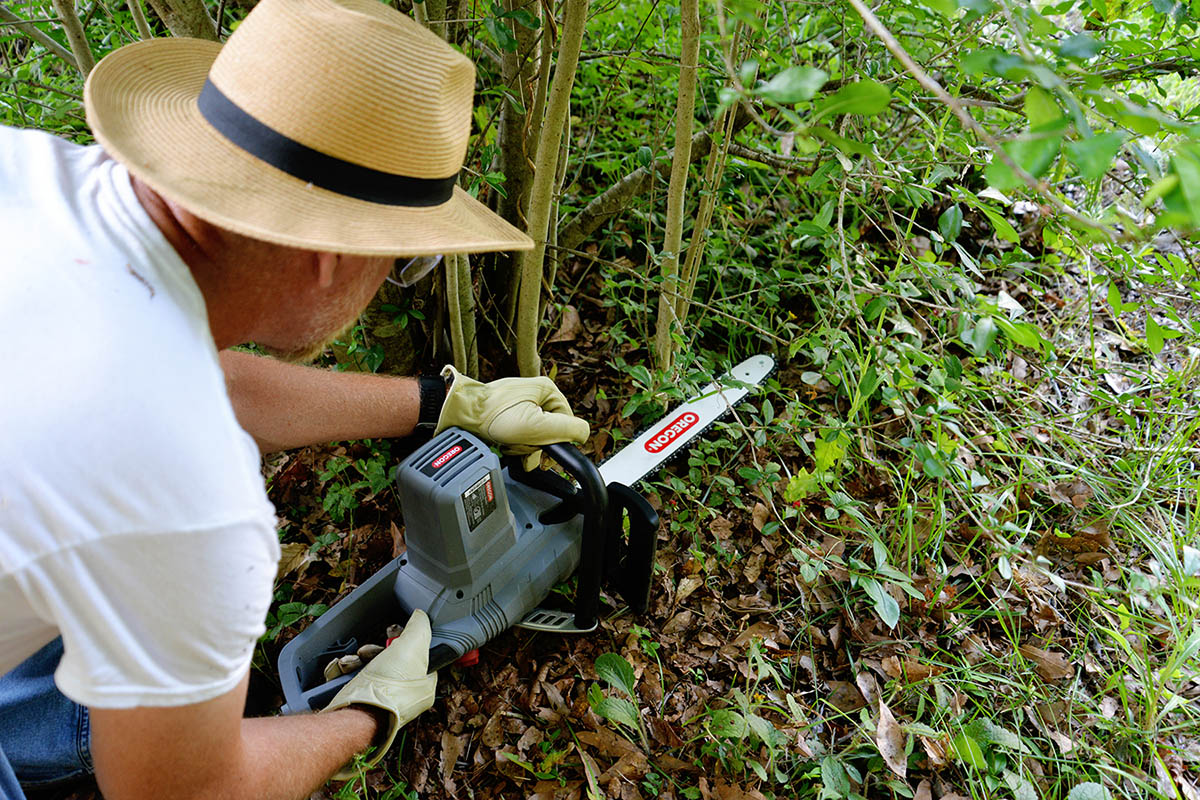
Our Top Picks
Woodcutting can be hard work, but buying the best small chainsaw shouldn’t be! In the reviews ahead, find out the technical specs, pros, and cons of each featured chainsaw plus how they performed in our real-life backyard tests.
Best Overall
Worx WG384 40V Power Share 14-Inch Cordless Chainsaw
See ItPowered by two 40V 2-amp hour (Ah) lithium-ion rechargeable batteries, the Worx WG384 cordless chainsaw features a 14-inch bar that is just the right size for small and midsize pruning and cleanup jobs. It boasts toolless automatic chain tensioning, automatic chain lubrication, and includes a safety chain brake. The efficient brushless motor extends battery life, and the batteries are compatible with all Worx Power Share 20V, 40V, and 80V tools.
In our tests, we appreciated the WG384’s performance quality as a basic backyard-worthy chainsaw for DIYers. The lightweight chainsaw proved to cut very well without binding in the wood, and the batteries lasted through 68 cuts, ranging from 4 to 12 inches in diameter. On the downside, the bar oil reservoir leaked a little when not in use, the automatic chain tensioner needed occasional manual adjustment, and it simply didn’t operate quite as comfortably and aggressively as our best battery chainsaw pick. But we found it more than adequate for occasional use at an attractive price to boot.
Product Specs
- Power source: (2) 20V 2Ah lithium-ion batteries
- Bar length: 14 inches
- Weight: 10.4 pounds
Pros
- Good power and size for occasional cleanup and pruning
- Value price point
- Lightweight and easy to use
Cons
- Bar oil reservoir may leak during storage
- Inconsistent automatic chain tensioning
Get the Worx WG384 small chainsaw on Amazon or at Lowe’s.
Runner-Up
Makita UC3551A 14-Inch Electric Chainsaw
See ItThe Makita UC3551A corded electric chainsaw cuts fast, operates efficiently, and keeps maintenance to minimum. The 14.5-amp motor has a built-in current limiter that protects the motor from burnout by reducing power when the saw is overloaded. The saw features a toolless chain-tensioning system, an electric chain brake, and an automatic chain oiler for heavy continuous cutting. There’s an ample oil reservoir, a large trigger switch with soft start for smooth start-ups, and ergonomic rubberized grip handles. Large metal bucking spikes grip material for safer, more efficient cutting.
Those who think corded outdoor power equipment is cumbersome or outdated might want to check out the Makita UC3551A chainsaw. In our experience, the comfortable ergonomic grip and oversize trigger plus the smooth start-up feature make it a pleasure to work with. While the chain moves much faster on this saw than most of the other electric chainsaws we tested, both corded and battery-powered, the comfort features and smooth-running electric motor made this model feel securely under control. The large bar oil reservoir allowed us to work steadily for more than an hour between fill-ups, and the engine showed no signs of stress. Those staying close to the house who need a hardworking saw will find this Makita a great choice.
Product Specs
- Power source: 14.5-amp corded electric motor
- Bar length: 14 inches
- Weight: 12.1 pounds
Pros
- Comfortable to work with
- Smooth operation
- Metal bucking spikes grip wood
- Extra-large bar oil reservoir
Cons
- Premium price point
- Oil leaks from the reservoir in storage
Get the Makita UC3551A small chainsaw on Amazon or at The Home Depot.
Best Bang for the Buck
Worx WG322 20V Power Share 10-Inch Cordless Chainsaw
See ItThe Worx WG322 helps reduce user fatigue, weighing in at a little more than 6 pounds, and it features a wallet-friendly price tag to match. This 10-inch saw is powered by a 20V 2Ah battery. Automatic chain oiler and chain-tensioner systems keep the saw running smoothly and extend the chain and bar life. This model is sold in a kit that includes a 20V 2Ah battery, a charger, and a blade guard for safe storage, all at a value price.
During testing, the shorter 10-inch bar came in especially handy for removing branches among densely congested growth. The compact size and freedom of movement (no worrying about an extension cord or pull-start) made it safer and easier to maneuver than a 14-inch saw. This Worx model lacked runtime, though, making just 43 cuts on 3-inch to 8-inch material on a single charge. Like most of the others we tested, this saw leaks bar oil when not in use, so it’s best to empty the reservoir at the end of the project. The lightweight, compact size and convenient battery operation make this a great choice for seasonal pruning projects and quick, occasional tasks like making the fresh cut on the bottom of the Christmas tree. And the low price? A cut above!
Product Specs
- Power source: 20V 2Ah lithium-ion battery
- Bar length: 10 inches
- Weight: 6.2 pounds
Pros
- Very lightweight
- Compact size is easy to maneuver
- Value price point
Cons
- Slow to recharge (about 4 hours)
- Cutting large material reduces battery life
Get the Worx WG322 small chainsaw on Amazon or at Lowe’s.
Best Battery-Powered
Makita XCU03PT 36V LXT Brushless 14-Inch Chainsaw
See ItBattery-powered chainsaws have come quite a long way, and we consider the Makita XCU03PT to be the king of the woodpile. This 14-inch bar chainsaw comes with a double charger and four 5.0Ah batteries, as the saw uses two batteries at a time. The brushless motor efficiently delivers a lot of power while also preserving battery life. The XCU03PT has as much power as a 32cc gasoline engine, making it capable of taking down small trees and cutting dense firewood like oak and maple. The chain adjustment is toolless, requiring the user to simply turn the knob on the side of the saw for the desired tension. It also has an automatic oiler and a view window to make sure there’s enough oil for the project at hand.
Our tests confirmed that this Makita cordless chainsaw is the right choice for top-end battery power and extended runtime. We made 83 cuts of 4-inch to 12-inch material on a single battery charge, and the second set of batteries was ready to go when the first set ran out. The depleted batteries recharged in less than 50 minutes on the dual charger, a rate that could have kept us rotating batteries and working steadily all day. The handle and trigger configuration were very comfortable and well-balanced. Of course, high-level performance comes at a premium price, but those who need a hardworking battery-powered chainsaw will appreciate this one.
Product Specs
- Power source: (2) 18V 5Ah lithium-ion batteries
- Bar length: 14 inches
- Weight: 11 pounds
Pros
- Fast charging and extended runtime
- Powerful and efficient brushless motor
- Quality bar and chain
- Includes a second set of batteries
Cons
- Premium price point
- Blade cover not included
Get the Makita XCU03PT small chainsaw at The Home Depot, Acme Tools, or Toolbarn.
Best Corded
Oregon CS1500 18-Inch Electric Chainsaw
See ItCutting firewood with a dull saw is not fun. To make it easier to maintain a sharp tool, Oregon created a self-sharpening electric chainsaw with plenty of power to boot. The CS1500 has an 18-inch bar and a self-sharpening lever that grinds a fresh edge onto the chain’s cutting teeth in 3 to 5 seconds. It has a 15-amp motor, an automatic oiler, and a reservoir view window for bar lube. It also uses a toolless chain tensioning system, which allows the user to adjust the chain to the proper tension and lock it back into place with ease.
We were really wowed in testing by the self-sharpening chain, a true game changer. To make sure the feature lives up to the hype, we spent a little extra time testing the Oregon CS1500, dulling the chain in order to put the self-sharpener through its paces. The biggest saw in our lineup, it easily cut through the largest 12-inch to 14-inch material that we had on hand with zero chain binding or motor bogging down. While the saw is heavier than most of those we tested, the extra weight helped balance the saw body and bar length, plus it added to the downward pressure for cutting large material.
When the blade finally did need sharpening, it only took about 5 seconds to grind a fresh edge with just the push of a lever (conveniently located near the index finger of the nontriggering hand). That feature saves 10 minutes of sharpening with a file per hour of cutting. This is a powerful electric saw conveniently and comfortably built for big jobs.
Product Specs
- Power source: 15-amp corded electric motor
- Bar length: 18 inches
- Weight: 12.5 pounds
Pros
- Self-sharpening chain
- Great for large cuts
- Powerful 15-amp motor
- Value price point
Cons
- Heavier than other saws
- Limited by power-cord length
Get the Oregon CS1500 small chainsaw at Amazon, The Home Depot, or Northern Tool + Equipment.
Best Gas
Echo CS-310 14-Inch Gas Chainsaw
See ItCorded electric and battery-powered chainsaws offer numerous benefits, but when conditions are the most demanding, a gas chainsaw is still the best option. The Echo CS-310 is powered by a 30.5cc 2-cycle gas engine, sports a 14-inch blade, and weighs just 8.8 pounds. It features an automatic clutch-driven oiler, side-access manual tensioner screw, and manual chain brake. Pull starts are easier with the help of a spring-assisted starter, and the saw boasts a fully variable speed trigger and an anti-vibration handle. Sold as a kit, it includes a scrench (an essential chainsaw maintenance tool with built-in screwdriver and spark plug wrench), bar scabbard, and toolless access filter cover.
After we mixed up a fresh batch of 2-cycle fuel and filled the tank, the Echo CS-310 started up on the second pull. It ran smoothly if not quietly and produced no visible smoke. It easily buzzed through hardwood logs up to 14 inches in diameter and ran for just over an hour on one tank (8.5 ounces) of fuel—we stopped counting at 100 cuts. Then, while some gas saws won’t start easily after they heat up, this one did on the first pull.
We would have preferred this saw to have metal bucking spikes for improved grip instead of the molded plastic ones. Note that gas engines work best when used frequently, so this model would be suited to someone who’ll use it on a monthly basis at least. It’s a great choice where access to electricity is limited or not available.
Product Specs
- Power source: 30.5cc 2-cycle gasoline engine
- Bar length: 14 inches
- Weight: 8.8 pounds
Pros
- Easy to start
- Lightweight
- Powerful smooth-running engine
- Value price point
Cons
- Molded plastic bucking spikes do not grip as well as metal
- Should be used at least monthly to preserve engine components
Get the Echo small chainsaw at Amazon, The Home Depot, or Chainsaws Direct.
Best Mini
Milwaukee M12 Fuel Hatchet 6-Inch Pruning Chainsaw
See ItPowered by a 12V 4Ah battery and efficient brushless motor, the Milwaukee M12 Fuel 6-Inch Pruning Chainsaw cuts hardwood up to 3 inches thick and delivers up to 120 cuts per charge. This commercial-grade electric pruning saw meets the ergonomic, performance, and durability needs of landscape professionals. It weighs less than 5 pounds and features a compact design to deliver increased control and maneuverability in tight spaces. Advanced electronics deliver an instant throttle response and a variable speed trigger for excellent power control. This compact saw features a “full house” chain (cutters on alternating chain links) for fast, smooth cuts; easy access tensioner; auto oiler; metal bucking spikes; and onboard scrench storage.
This Milwaukee 6-inch pruning saw is unique among the saws we tested in that it is constructed for one-handed use. At just over 4 pounds, it’s fairly lightweight and well balanced. The body of the tool is a bit bulky, but the short blade fits nicely into tight spots without risking collateral damage to branches we wanted to leave on the tree. Our test cuts were smooth, fast, clean, and plentiful, buzzing through 81 cuts from 2 to 4 inches in diameter on a single charge.
Two issues humble the saw slightly. First, awkward placement of the safety switch at the limit of thumb reach may be difficult for those with smaller hands to operate. Second, as noted with some other saws, this model leaks oil when not in use. All in all, though, we deem this a powerful little saw that could be an excellent choice for those with extensive pruning projects.
Product Specs
- Power source: 12V 4Ah lithium-ion battery
- Bar length: 6 inches
- Weight: 4.1 pounds
Pros
- One-handed operation
- Extended runtime
- Maneuvers well in tight spaces
- Fast, clean cuts
Cons
- Premium price point
- Bulky body
- Awkward safety switch placement
Get the Milwaukee small chainsaw at The Home Depot, Ace Hardware, or Amazon.
Also Consider
Ego Power+ CS1401 14-Inch Chainsaw
See ItThose looking for gas-like power in a battery-fueled chainsaw may want to check out the Ego Power+ CS1401. Powered by a 56V 2.5Ah rechargeable lithium battery, this chainsaw features a 14-inch bar, automatic chain oiler, toolless manual tensioner, weather-resistant construction, and a high-efficiency brushless motor to extend battery runtime and overall tool lifespan. The battery is compatible with all Ego Power+ ARC Lithium tools, including mowers, blowers, trimmers, and many more.
We’ve tested a variety of cordless yard-care tools from the Ego Power+ 56V lineup with favorable results, and the CS1401 cordless chainsaw continues the trend. In our tests it compared favorably with the competition. The battery lasted through 76 cuts of 4-inch to 12-inch material. At 11.4 pounds, it was the heaviest battery-powered saw we tested, but it was quiet and fast cutting—though not as fast as the Makita XCU03PT. This saw is part of an extensive group of consistently capable tools that can share batteries, a considerable advantage that saves money and space. Anyone who already owns tools in the Ego lineup should find adding this chainsaw a no-brainer.
Product Specs
- Power source: 56V 2.5Ah lithium ion battery
- Bar length: 14 inches
- Weight: 11.4 pounds
Pros
- Ample power for average yard cleanup and occasional high-demand work
- Plenty of runtime per charge
- Shares a battery with lots of other tools
- Comfortable to hold and easy to use
Cons
- Plastic ridges instead of metal bucking spikes
- Leaks bar oil when stored
Get the Ego Power+ small chainsaw at Amazon, Lowe’s, or Acme Tools.
Our Verdict
Although gas-powered small chainsaws were the standard for nearly a century, modern electric chainsaws are just as effective for backyard users. Plus, they’re far more convenient than gas-powered models, which require mixing up batches of fuel, cleaning air filters, and changing spark plugs. Those who want grab-and-go freedom in a convenient battery-operated tool will appreciate the affordable Worx WG384. Those needing unlimited runtime and a few more ergonomic features should seriously consider the Makita UC3551A.
How We Tested the Best Small Chainsaws
In order to test these chainsaws in ways most homeowners would use them, we assembled nine logs of various types and sizes ranging from about 4 to 12 inches in diameter. Moving from one log to the next, we used each chainsaw to cut rounds of every size off the ends, observing power, speed, accuracy, noise, vibration, and overall user comfort. For the battery-powered saws, we continued cycling through the different log sizes until the battery was depleted, counting the number of cuts. We did the same with the gas saw until it ran out of fuel.
In a second, less formal test, we simply cleared some brush piles with the saws. In this setting, we were better able to judge which models were more or less capable of working in dense vegetation. Of course, the deck was sort of loaded here: The best saws in this scenario were the short-bladed, cordless models.
After field testing, we scored each of the small chainsaws according to a rubric that compared objective measurements and answers to subjective questions according to the tester’s experience. This allowed us to compare and contrast the different models, generate our lists of pros and cons, and assign award titles.
The Advantages of Owning a Small Chainsaw
There are a lot of advantages to owning a small chainsaw. Secure storage, ease of use, and affordability are all benefits.
Storing a small chainsaw in a garage or workshop is fairly easy. The options included in our top picks list can sit on a shelf, under a worktable, or anywhere there is space. Larger chainsaws are harder to situate and may be too heavy for some shelves.
Smaller chainsaws are generally easier to use, as most are DIY models. These saws have plenty of power and safety features but are lighter than larger saws. Plus, there isn’t the need to hire a professional to do this kind of yard work.
On the subject of saving money, a smaller chainsaw is often less expensive than a larger unit. Since many are electric- or battery-powered, they’re less costly to maintain as well. A simple chain sharpening and a bottle of bar lube will usually keep a saw in running condition for years.
- Smaller chainsaws are capable and easier to store than larger saws.
- Smaller chainsaws are more comfortable to use than larger saws.
- Smaller chainsaws are more economical than larger saws.
FAQs
Even if you have a chainsaw model in mind now, you may still also have some questions. Here are answers to some of the most frequently asked questions about the best small chainsaws.
Q. How lightweight do chainsaws come?
Small chainsaws can weigh anywhere between 6 and 20 pounds. The weight depends on their power source, how many batteries they use, and their construction materials.
Q. Do you need to wear special gear when using a chainsaw?
Absolutely. Chainsaws can be dangerous; there is no denying that. When operating a chainsaw, protect yourself by wearing chainsaw chaps, sturdy boots, and both eye and ear protection as well as a pair of properly fitting work gloves.
Q. What can you cut with a small chainsaw?
There are many situational factors that can limit what a chainsaw can cut, but a small chainsaw can cut woods like pine, cedar, birch, and oak. Avoid operating the saw where the blade might contact soil, rock, metal, or concrete. Also use extreme caution when working near utilities like gas, electric, and waterlines.
